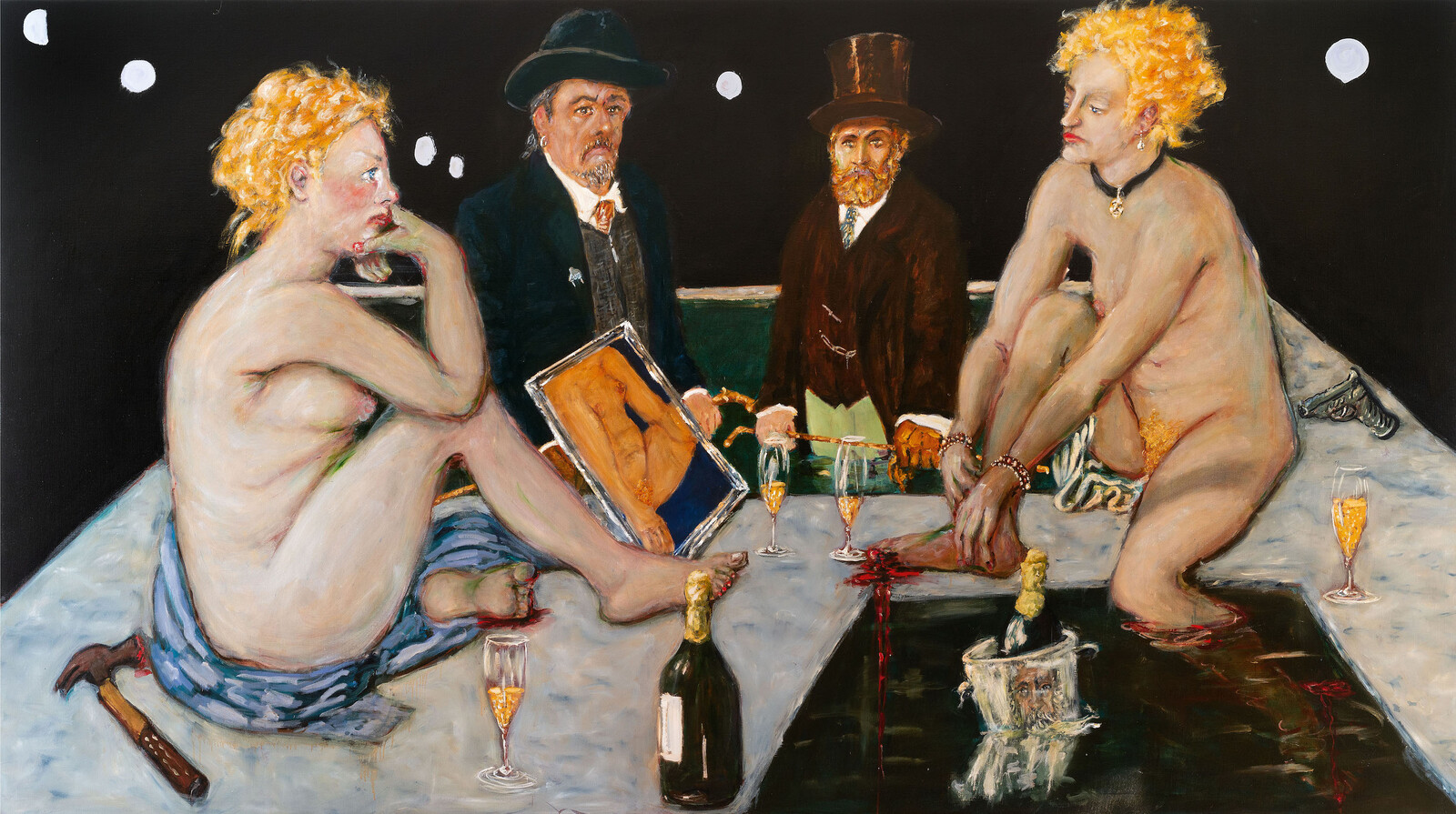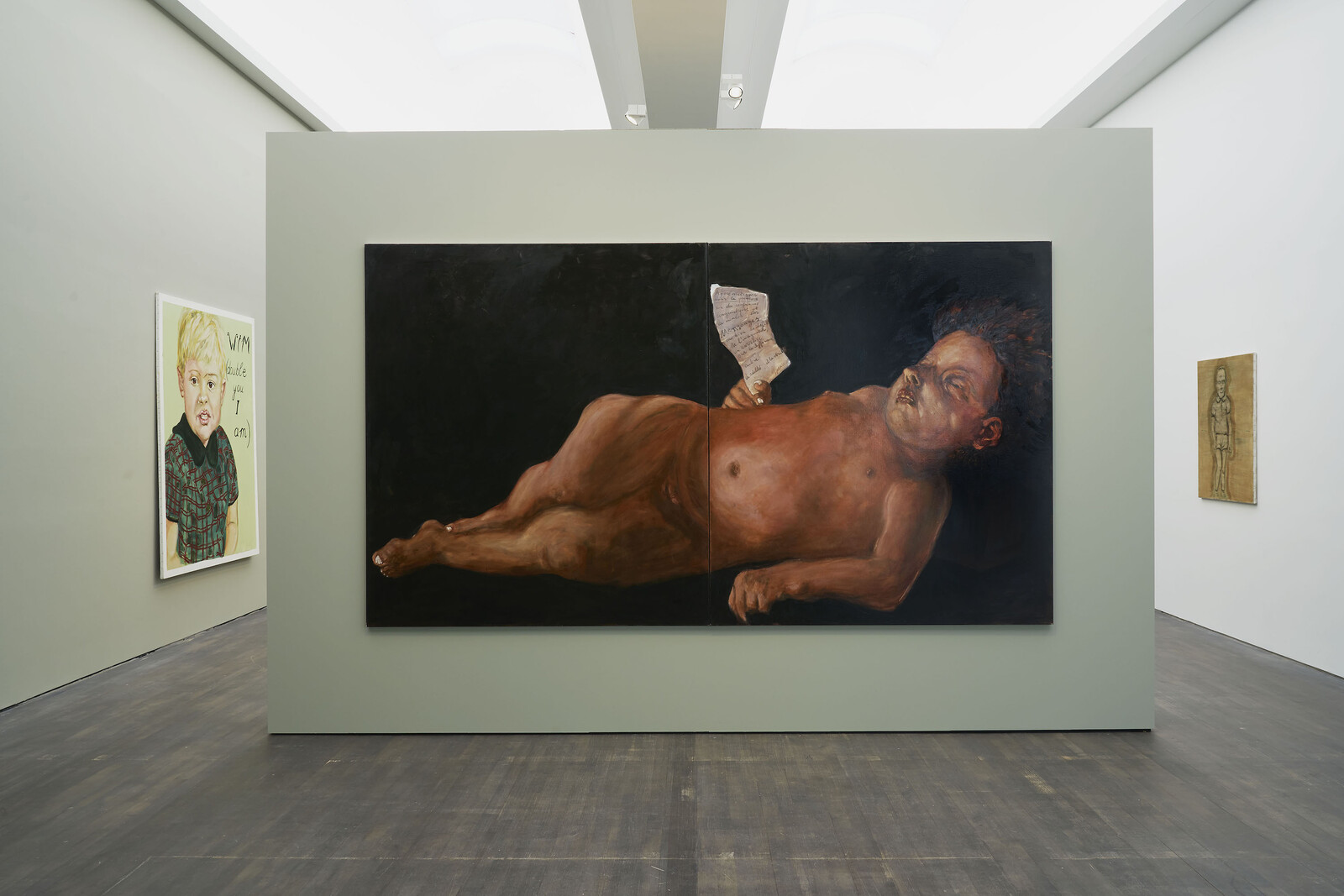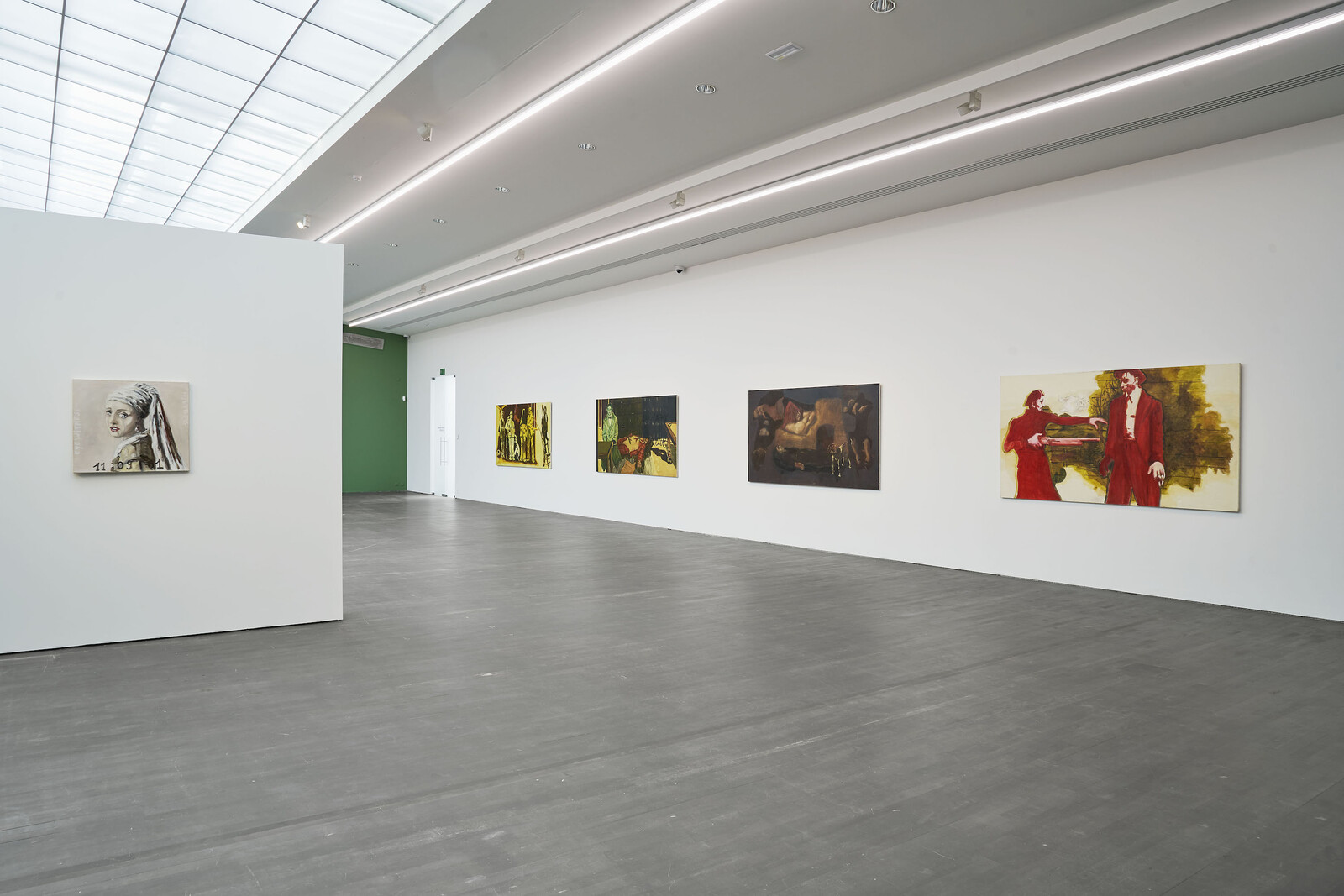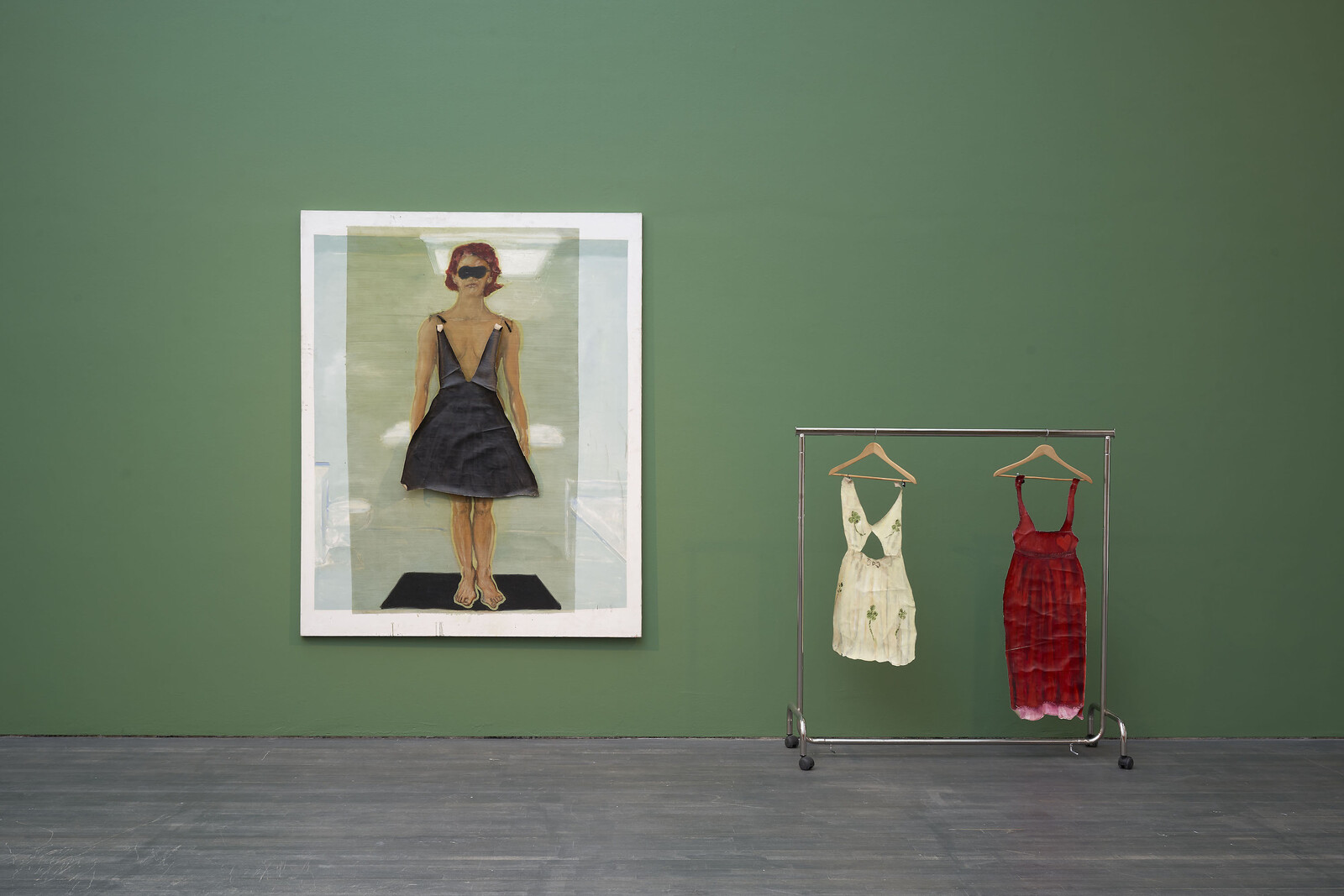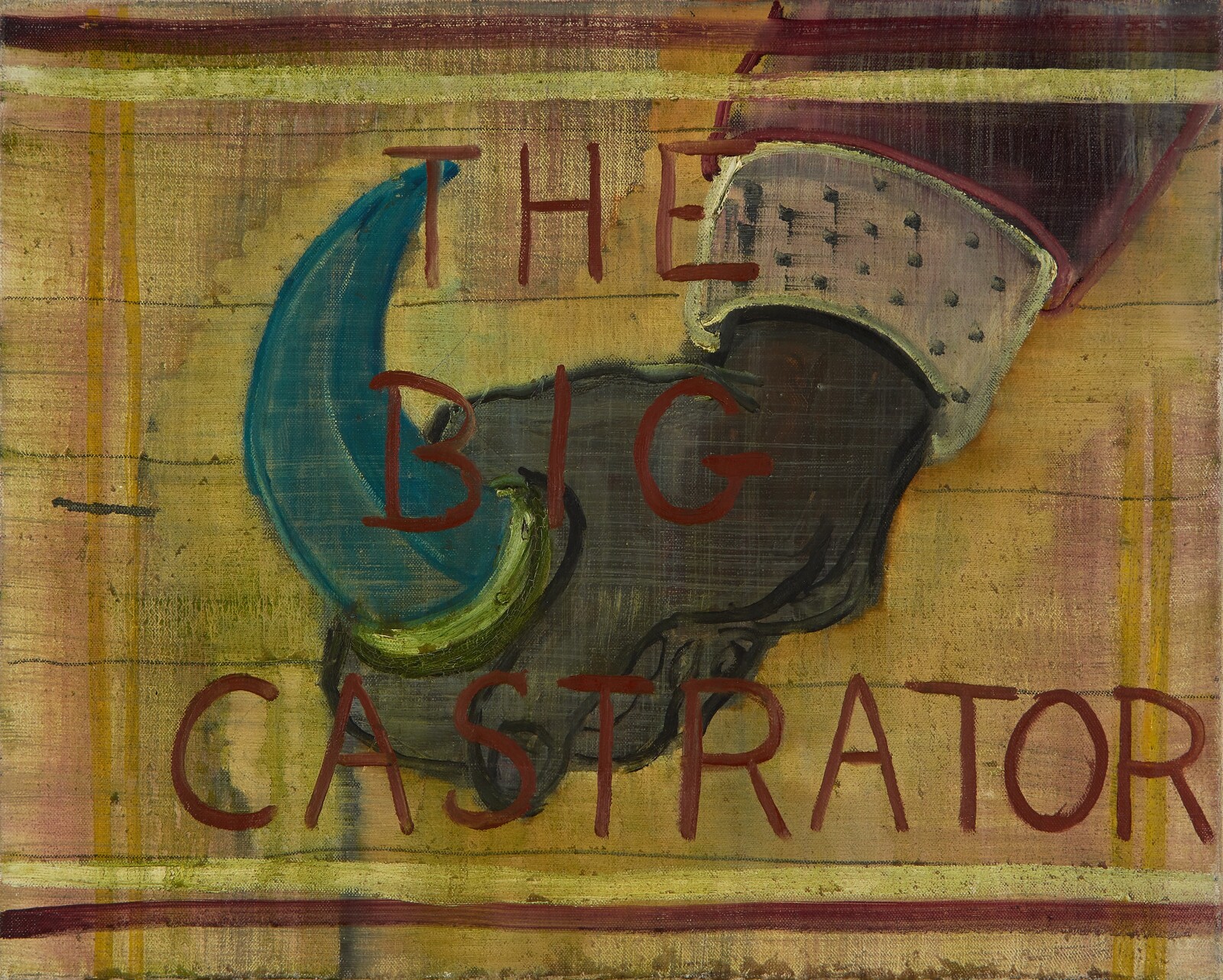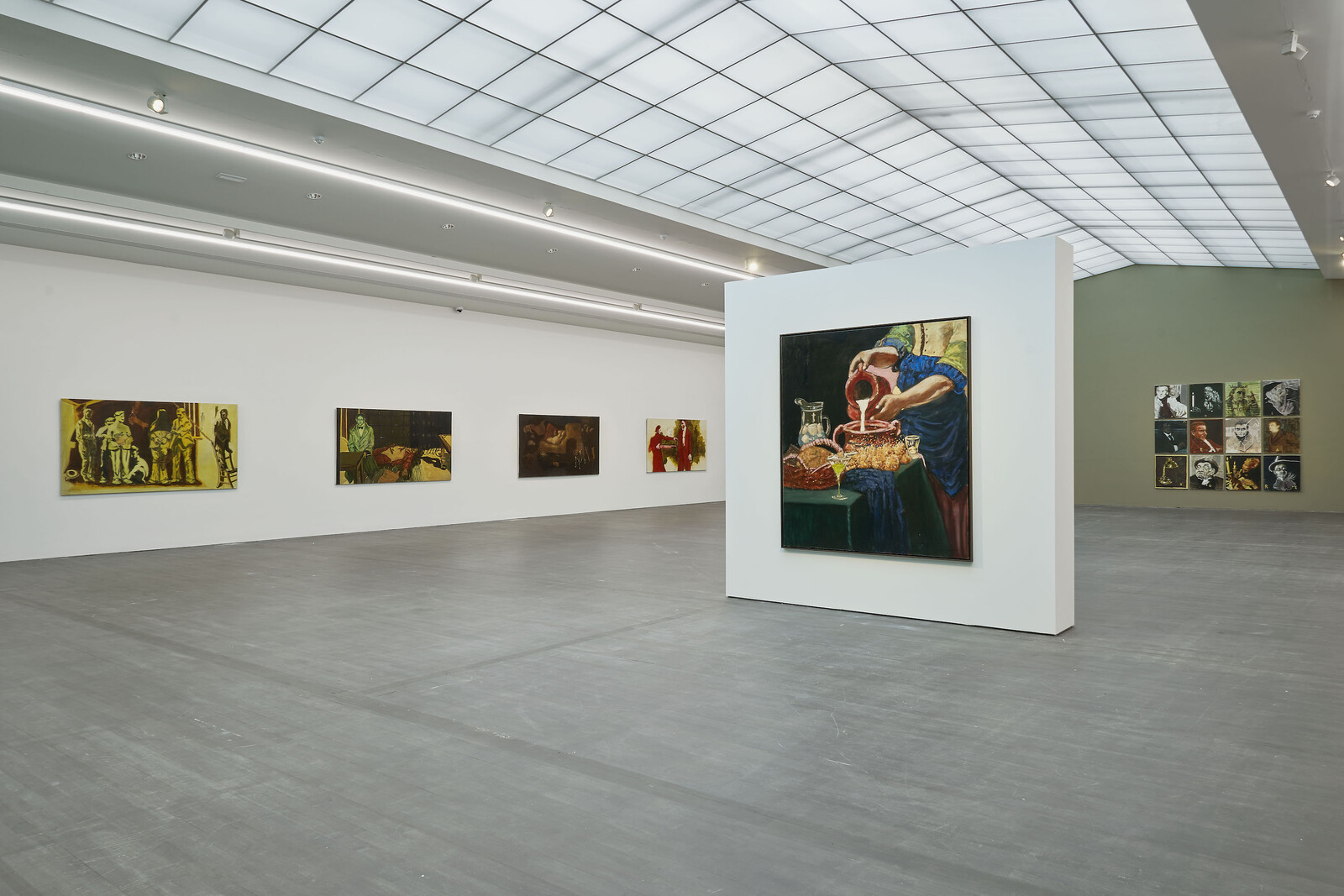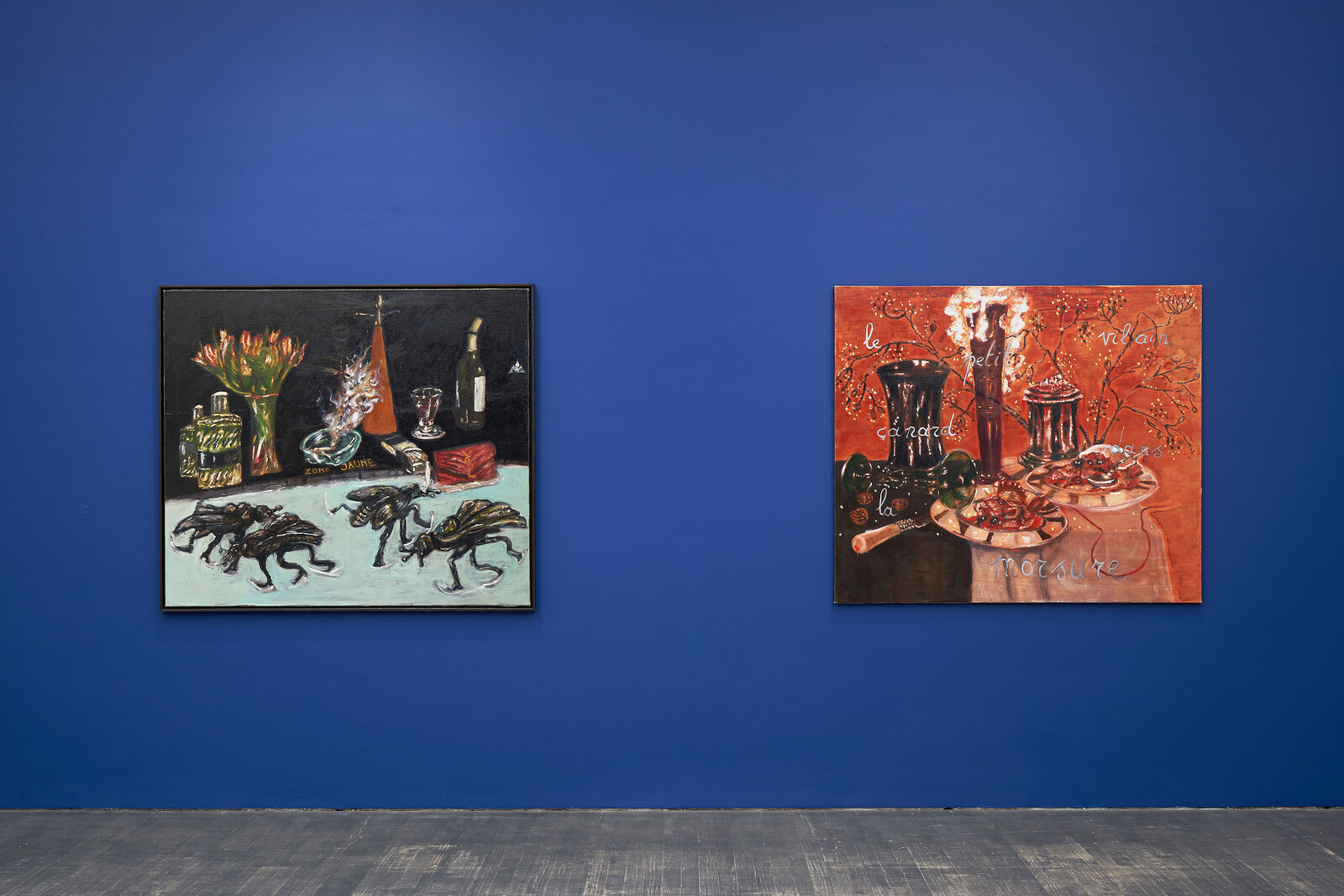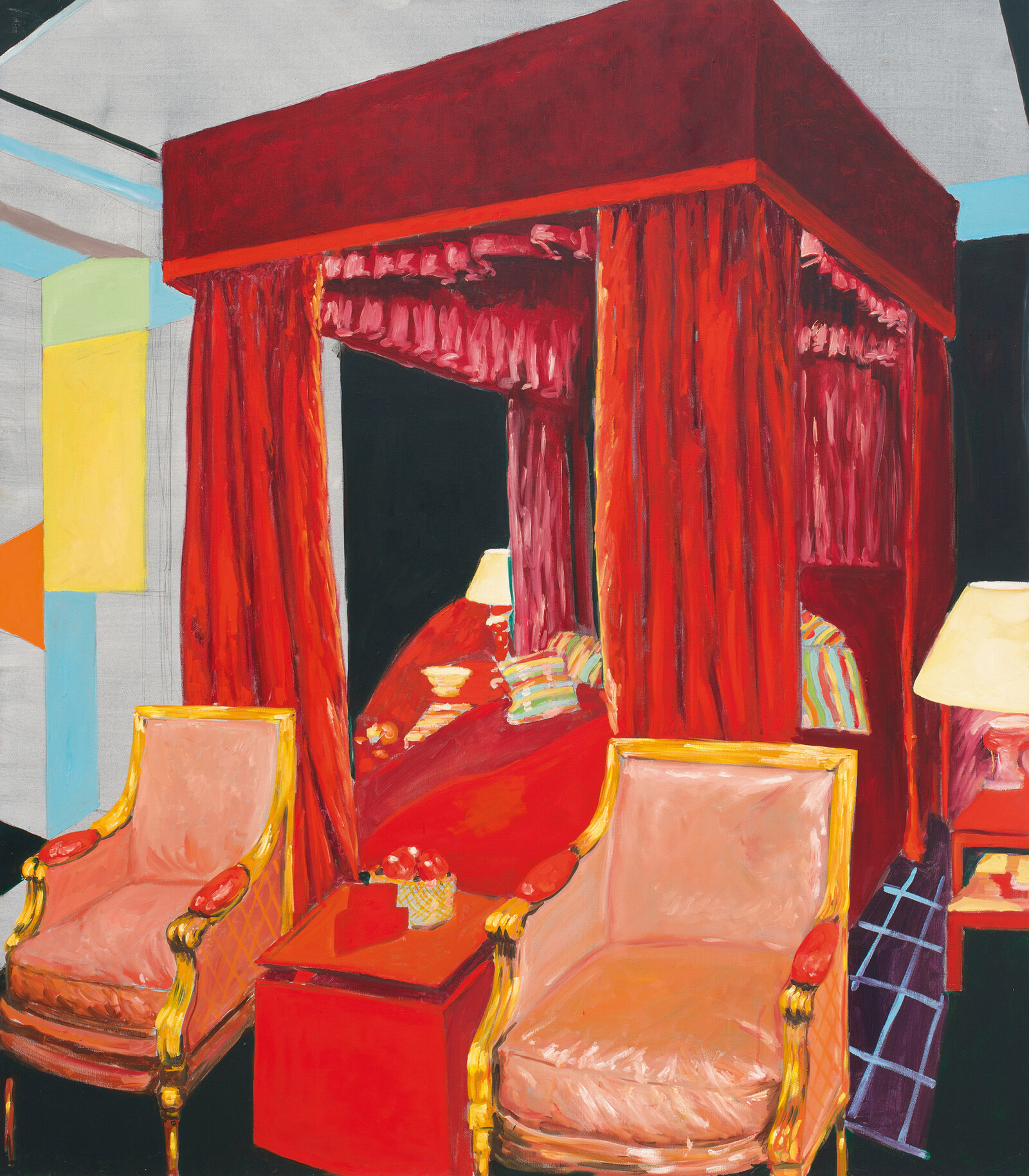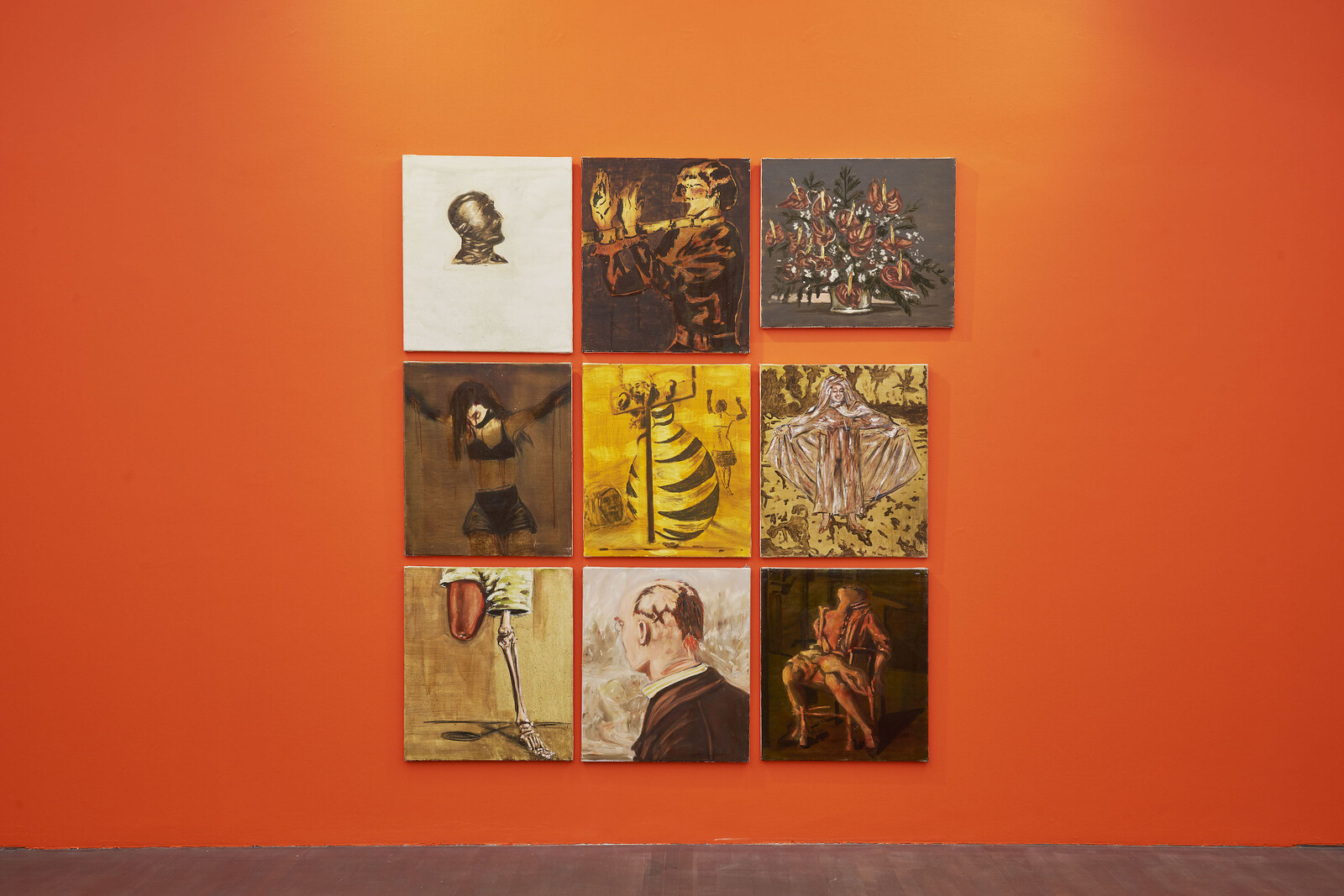Belgian painter Jan Van Imschoot’s first major retrospective—the show that should gain him the belated international recognition his work deserves—spans four decades, seven rooms, more than eighty paintings, a bar, and a small cinema. And it starts with a landscape-format painting sitting smack across the entrance. A cherub or cupid, though with no wings, painted much larger than life, reclines against an indistinct, darkly looming background. The little big fellow has apparently nodded off, his nipples, shiny belly bottom, and tiny weenie standing out like bumps and craters on the surface of a full moon. The motif and the title Amore Dormiente (2018) pay direct homage to Caravaggio’s Sleeping Cupid (1608), a small painting at home in the Uffizi.
But homage immediately turns into, well, what? Parody? Grotesque exaggeration? In this adaptation, cupid’s face is wreathed by a shock of auburn hair, a rather adult skyward nose, sagging cheeks, and eyes swollen half-shut, like an old drunk’s. Instead of a bow and arrow in his left hand, in his right he holds a handwritten letter in French, signed by van Imschoot, which translates as: “Aposematism in painting: on linguistic confusions and the mimesis of lies, or the challenge of the imagination, an exercise in the difference between reality and truth.” The term Aposematism—the use of glaring colors by animals to signal toxicity—hints at the aesthetic as well as ethical games of confusion lying in wait for visitors to the ensuing exhibition. And that hint is amplified by the painting’s subject and title. During the Counter-Reformation, it became more common to depict the Roman god of love as a chubby infant rather than, as previously, a handsome adolescent; and to depict him sleeping was probably a coded allusion to desires curtailed, the vow of monastic chastity (the picture had been commissioned by Fra Francesco dell’Antella, commander of the Order of Malta). But, of course, what sleeps can wake.
Van Imschoot was born in 1963 in Ghent, the city of this retrospective, and also the town where its curator, Dieter Roelstraete, studied. In Ghent, the weight of Flemish and Dutch art history is not easy to shrug off. Across the street from S.M.A.K., the MSK Museum of Fine Arts houses, amongst many other masterpieces, Hieronymus Bosch’s painting of his namesake Saint Jeróme (ca. 1485–95), depicting a familiar subject (the saint’s penitence in the desert) enriched with Bosch’s characteristically bizarre details (such as a broken red globe floating in a pond). It also houses Luc Tuymans’s fresco The Arena (2017), which is based on an earlier series of paintings exploring the ambivalence of the arena as a peaceful forum as well as potential battlefield, not least in reference to Goya’s The Third of May 1808 (1814) with its radically modern depiction of the horrors of war.
Van Imschoot certainly carries these forebears and many more with him, but without making himself comfortably at home in referential hell. Hung near Amore Dormiente are more depictions of young boys: a small self-portrait from 1995 depicts, with Tuymans-esque curtness, the photo (including border and shadow as if pasted into an album) of a melancholic boy, in muted brushstrokes and charcoal delineations. The picture seems drained of all color but that of a maroon bow-tie, as if that bow-tie was already, as he entered the educational system, suffocating the artist at the age of six (Mei 1970/het aantreden [May 1970/The Enrollment], 1995). The other picture, more glaringly colored and in-your-face, shows an awkwardly smiling blond boy sitting for a portrait photograph, again with a border indicating the photo print; “WIM (double you I am)” is written next to his face, and together with the title of the piece Rire comme en mourire [Laughing like Dying] (2001) we understand it to be a hint at brotherly relation. With these three paintings (and some more) in the first room, a beginning as well as a biography is sketched in sparse aptitude: the founding feelings of a middle-class family upbringing, as well as the awakening of a love for painting, with its games of truthful deceptions and restrained transgressions personified as Amor.
As the second room shows us, it didn’t take long for that love to become beastly. These works from the late 1990s project sadomasochistic fantasies and the gruesome realities of war. This section begins with another self-portrait of Imschoot, looking a bit like the late Marlon Brando lurking in the shadows. With his eighteenth-century hairdo and earrings, smoking a cigarette with tears in his eyes, the mouth a blood-dripping mess, Brando seems to have been cast as a cannibal-vampire pirate (Tasting the colour red, 2018). The painting sits on a red wall across from a catalog of atrocities in which sexualized tortures and de-personified war mutilations are depicted with almost religious fervor. These horrors are at their most condensed in a set of nine small paintings forming a grid constituting Minuet of a sold skin (1999): like glimpses of a memory card game conceived by Georges Bataille, we see a close-up of a pair of legs tucked into a pair of shorts, one of which is amputated and one skeletonized; a grinning nun in a translucent robe spreading her arms to reveal her naked body; a bulbous wasp with a human head and hands fastened into a pillory.
As Van Imschoot said himself in a 2021 interview, in reference to everything from the 2015 Charlie Hebdo shootings in Paris to televised ISIS beheadings, “once the violence gets closer, I’m blocked.”1 And for the better, one might add, since that blockage is a more useful reflection of painting’s potentials and limits than smug, supposedly subversive incantations of debauchery and torture. At the same time, the blockage is a kind of internal Bilderverbot, somewhat connected to Claude Lanzmann’s notion of a “ring of fire” around the Shoah, scorching any attempt at literal illustration. Thus it may release analytical energies elsewhere, so that inhumane crimes are indicated not by disturbingly repulsive images, but rather by uncanny allusion. This is the case most strangely and vividly in a painting of three chefs with white hats and smocks in a row, throwing flakes of flour onto a surface, with their heads vanishing entirely into the void of the pitch-black background. The combination of such a mysterious and mechanical-seeming scenario with the work’s German title—Ein Augenblick rüht die Arbeit [A moment’s rest from work] (1996)—seems already to hint at the depths of historic guilt.
But just as one starts worrying about an uninterrupted continuation of this darkly brooding (dare one say, typically Belgian) heritage of encrypted, surrealist visualizations of the uncanny—stretching from Bosch via James Ensor and René Magritte to Michaël Borremans—a silvery thread of blackish, absurdist humor starts to glitter. While that thread might ultimately be traced back to Ensor, it also connects Van Imschoot more directly to contemporaries from Martin Kippenberger to Nicole Eisenman. Death Row Fashion II (2002) is a deadpan travesty of consumerism, misogyny, political irresponsibility, and not least, painting: a woman is depicted at life-size standing frontal to the viewer, in a washed-out prison cell, with a sleep mask on. If you don’t like the short black skirt she is wearing, you can replace it with one of the alternative dresses, painted onto canvas (including a white one with four-leaf clovers and a red one with hearts), that hang on a neighboring clothes rail. A somewhat pompous picture of an even more pompous four-poster bed with two pink Louis XV club chairs with golden armrests in front of it, set in an otherwise modernist luxury hotel room, bears the hilarious title The press release (2009). And we all know how that that press release reads.
Skill as much as nonchalance guides Van Imschoot’s brush and palette in works paying homage to painterly paragons. A rather 1980s-style retro cover-version transfers Édouard Manet’s Le Déjeuner sur l’herbe [The Luncheon on the Grass] (1862–63) to a nighttime swimming pool (L’échange des bêtises [The Nonsense Exchange], 2021); a portrait of the young Sonia Delaunay is staged like a glamour shot (La reconnaissance de Sarah Stern par une peintre anversoise, 2022). And just as you start worrying about Van Imschoot getting carried away with homages to his heroes and heroines (Tintoretto, film pioneer Alice Guy-Blaché, etc.), a series of frivolously irresponsible, yet loving transgender nudes signed “Fucking Imschoot” (“Ladyboy / curliemen,” 2007) comes to the fore; or voluptuously indulgent parodies of Golden Age still lifes that speak of gluttony or binge drinking, for example with Le pari pour Paris [The Paris Gamble] (2021) featuring four flies ice-skating in front of an arrangement of ashtray, whiskey bottle, and flower bouquet.
The mood having been set, the bar turns out to be closed (although it also turns out to be a spatial still life, resurrecting stuffy 1960s pub feelings) while the cinema unfortunately only features trailers of classics by Pasolini or Buñuel (surely thanks to the sheer unaffordability of securing rights for extended sequences). But just when you thought the show had petered out, a final stinging reminder against complacent, sexist dude attitudes appears: a small canvas featuring a hand holding a curved dagger, with capital letters reading The big castrator (1995). Which brings us back to the beginning of the show, its delineation of upbringing and violence, and the drama of the gifted child, as an artist’s whole life is anticipated in Cupid’s awkward nudity: too big and too small, too soft and too harsh, too sophisticated and too clumsy, too sensitive and too benumbed—but, exactly because of that incongruity, just right.
Geert Van der Speeten, Interview with Jan Van Imschoot “‘Met avant-garde heb ik nooit hoog opgelopen’,” De standaard (December 11, 2021), https://www.standaard.be/cnt/dmf20211209_96569812.
